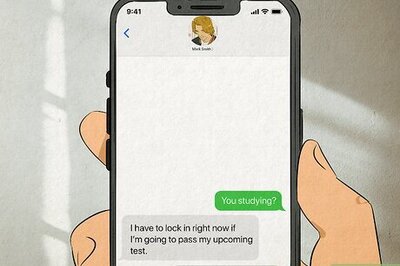
views
Washington: A typical college student uses his smartphone or tablet an average of 11 times a day while in class - mostly for texting, checking emails or tweeting - according to a new US study.
Nearly 86 per cent of the students surveyed said they text during a class, while 68 per cent said they check emails, and 66 per cent admitted to using social networks.
Thirty-eight per cent said they surf the Web and 8 per cent said they play a game during classes, found researchers from the University of Nebraska-Lincoln (UNL).
More than 80 per cent students admit that their use of smart phones, tablets and laptops can interfere with their learning. More than a fourth said their grades suffer as a result.
Barney McCoy, an associate professor of broadcasting at UNL, surveyed 777 students at six universities in five US states in 2012 about their classroom use of digital devices for non-instructional purposes.
The students, from UNL and the University of Nebraska at Omaha in Nebraska, Morningside College in Iowa, the University of North Carolina, the University of Kansas and the University of Mississippi, were recruited for the computer survey by classroom instructors via email and personal contact.
Thirty-five per cent said they used their digital devices for non-classroom purposes 1 to 3 times per day while 27 per cent did it 4 to 10 times a day.
Some 16 per cent played with their devices 11 to 30 times during the day, and 15 per cent did it more than 30 times.
Only 8 per cent said they never use their devices during class for non-classroom purposes.
Also, 79 per cent of the students said they used their digital device to check the time.
The top advantages of using digital devices for non-class purposes, according to students, are staying connected (70 per cent), fighting boredom (55 per cent) and doing related classwork (49 per cent).
However, students downplayed the distraction caused by digital devices. Fewer than 5 per cent considered it a "big" or "very big" distraction when classmates used digital devices and fewer than 5 per cent considered their own use of a digital device to be a "big" or "very big" distraction.
More than half the students said they were "a little" distracted when other students pulled out their devices and nearly 46 per cent said they were "a little" distracted by their own use of digital devices.
More than 91 per cent said they opposed a classroom ban on digital devices. Their preferred policy (72 per cent) for dealing with digital distraction is for the instructor to speak to the offender.
They also preferred a first-offence warning, followed by penalties (65 per cent) for those caught using devices for non-classroom purposes.



















Comments
0 comment